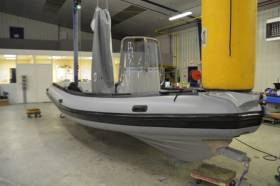Displaying items by tag: Christophe Maupaté
#Solo - Pictured above is the RIB that French sailor Christophe Maupaté will pilot solo in his quest to set a new Atlantic record from Bordeaux to New York.
Previously attempted by Ireland's own Enda O'Coineen, no one has yet completed a solo transatlantic voyage by RIB.
But as reported on Afloat.ie last December, Figaro veteran Maupaté has been planning his own crossing for some time, having plotted a 4,460-nautical-mile course that will take him from France via Ireland's East Coast, western Scotland, the Faroe Islands and Iceland to the southern tip of Greenland and Canada's Maritimes towards the US – tracing the route of Lafayette's Hermione.
Now Maupaté's record attempt is just weeks away, launching from Bordeaux on Saturday 16 July with a stopover in Dun Laoghaire expected in the first few days.
French Solo Sailor Aims For Atlantic RIB Record
#Solo - French sailor Christophe Maupaté aims to follow in the wake of Ireland's own Enda O'Coineen in his attempt to be the first person to cross the Atlantic solo from Bordeaux to New York by RIB.
The Figaro veteran will set off on 16 July 2016 from Bordeaux heading north, via the Celtic and Irish Seas – including a stop-over in Dun Laoghaire – on an epic voyage that will see him trace a semi-circle around the North Atlantic.
That route takes Maupaté via the Orkneys, Iceland and the southern tip of Greenland to Canada's Maritimes provinces and onward to New York to coincide with a commemorative voyage by a replica of historic French general Lafayette's ship Hermione.
And he'll be doing it all single-handedly in a 7.5m RIB, a custom French-built Zeppelin, equipped with a Suzuki four-stroke outboard motor and Garmin navigation and communication devices.
The Atlantic has been crossed by RIB several times before, most notably by TV adventurer Bear Grylls and team in 2003 from Canada to Scotland, and more recently by the Brown brothers from Florida to London in 2009.
But the closest anyone's come to a solo RIB crossing was Enda O'Coineen, when he helmed the 5.5m Zodiac RIB Kilcullen III from Halifax in Nova Scotia to Dunmore East in the mid 1980s – a voyage recounted in his book The Unsinkable Kilcullen.
There is no Guinness World Record for O'Coineen's feat, so Maupaté aims to be the first into the books with his own incredible expedition of some 4,460 nautical miles.
More details can be found on the official Bordeaux -> New York in Solitare website HERE.
























































